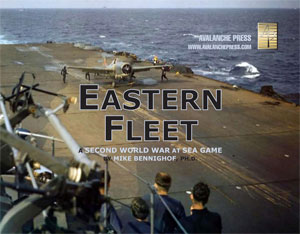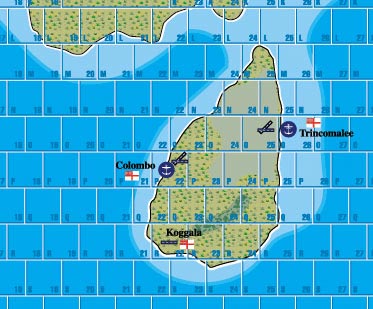| Eastern Fleet:
Designer’s Notes
By Mike Bennighof, Ph.D.
December 2017
 A while back, my assistant found a series of cartons in our warehouse, all filled with playing pieces for Second World War at Sea: Eastern Fleet. I’d known that we had at least one such box, but hadn’t been sure that we had enough of them to use in a new edition of the game. And after some rifling through our archives, I found the original file for the game’s map. A while back, my assistant found a series of cartons in our warehouse, all filled with playing pieces for Second World War at Sea: Eastern Fleet. I’d known that we had at least one such box, but hadn’t been sure that we had enough of them to use in a new edition of the game. And after some rifling through our archives, I found the original file for the game’s map.
That laid down the design challenge: build a new game on the same topic, using the exact same game pieces, and the same map artwork though the text and symbols could be altered. Scenario book, charts and any other components could be brand-new, but we weren’t about to throw out the pieces and base map.
Rules would also be brand-new, but that wasn’t really part of the challenge since we use the exact same rulebook and charts and such for every game in a series and all Second World War at Sea games will be receiving the new rules starting with Eastern Fleet, Midway Deluxe Edition and Tropic of Capricorn. So the rules would have needed editing and layout anyway.
 What I wanted from Eastern Fleet’s Second Edition was a game that would give plenty of play value, tell the story of the brief Indian Ocean campaign of 1942, and serve as an introduction to Second World War at Sea in general and the new Second Edition rules in particular. All of those goals could be met with the right mix of scenarios, using the story-arc format developed for Panzer Grenadier and our alternative-history settings. What I wanted from Eastern Fleet’s Second Edition was a game that would give plenty of play value, tell the story of the brief Indian Ocean campaign of 1942, and serve as an introduction to Second World War at Sea in general and the new Second Edition rules in particular. All of those goals could be met with the right mix of scenarios, using the story-arc format developed for Panzer Grenadier and our alternative-history settings.
As I’ve written elsewhere, I’ve come to appreciate the battle scenario as an instrument to both add to players’ fun and help move the story forward. The new Eastern Fleet has many more battle scenarios than the first edition, and they’re woven into the narrative to help show what happened and what could have happened.
 There are actually multiple story arcs in the scenario set, small ones looking at different aspects of the campaign. At the heart is the Japanese Operation C, the April 1942 raid into the Indian Ocean by the First Air Fleet and its five fleet carriers, opposed by the much smaller British Eastern Fleet with just two first-line flattops. The Japanese have all the advantages, or close enough – the British do have a quartet of ancient battleships with heavier guns than any Japanese surface ship, and a secret naval base. Scenarios include the historical operation, plus several variations on the theme and battle scenarios that might have arisen from the Japanese raid. There are actually multiple story arcs in the scenario set, small ones looking at different aspects of the campaign. At the heart is the Japanese Operation C, the April 1942 raid into the Indian Ocean by the First Air Fleet and its five fleet carriers, opposed by the much smaller British Eastern Fleet with just two first-line flattops. The Japanese have all the advantages, or close enough – the British do have a quartet of ancient battleships with heavier guns than any Japanese surface ship, and a secret naval base. Scenarios include the historical operation, plus several variations on the theme and battle scenarios that might have arisen from the Japanese raid.
And we have the other, lesser-known operations in the Bay of Bengal, like the Japanese invasion of the Andaman Islands in March 1942 and the operations to support the invasion of Burma. These were risky undertakings on the part of the Japanese, as the British had the strength in the theater to wreak havoc on their convoys. That danger would lead directly to the First Air Fleet’s foray into Indian waters, in an effort to destroy or at least weaken British naval capabilities in the theater.
Finally, the historical operations are rounded out with a pair of large-scale Allied convoys routed across the Eastern Fleet map, with the Japanese dared to do anything about it.
 Among those operations that never took place, the centerpiece is Operation Number Eleven, the planned Japanese invasion of Ceylon. The Imperial Japanese Army refused to provide the ground forces – five divisions – for an operation that easily could have left them stranded far from rescue or re-supply. And as the scenarios show, they were probably right. The Japanese can probably force their way onto Ceylon, the large island off the southeastern tip of India known today as Sri Lanka. Staying there is another question, as the troops will have to survive on more than just orange pekoe, so once the landings have been effected and the garrison subdued, the Japanese will have to run convoys of their own across the Bay of Bengal, usually without the cover of their carriers. Among those operations that never took place, the centerpiece is Operation Number Eleven, the planned Japanese invasion of Ceylon. The Imperial Japanese Army refused to provide the ground forces – five divisions – for an operation that easily could have left them stranded far from rescue or re-supply. And as the scenarios show, they were probably right. The Japanese can probably force their way onto Ceylon, the large island off the southeastern tip of India known today as Sri Lanka. Staying there is another question, as the troops will have to survive on more than just orange pekoe, so once the landings have been effected and the garrison subdued, the Japanese will have to run convoys of their own across the Bay of Bengal, usually without the cover of their carriers.
Even the invasion would have had to take place without the powerful First Air Fleet, which lost four of its six carriers at Midway in early June. No invasion could have been made ready until the summer of 1942, by which time the carrier fleet (now re-designated Third Fleet) would have had but two fleet carriers and one light carrier. The British counter with three fleet carriers, but each of them carries fewer planes (the two big Japanese carriers have, together, 120 percent of the flight deck capacity of the three British flattops, and they operate more capable airplanes from them).
All told there are 30 scenarios, a mixture of sizes, lengths and types of action including introductory scenarios to help new players walk their way through the game rules. Second World War at Sea isn’t a difficult game to play by any means, but even so we want it to be widely accessible to players old and new.
As with all of our boxed games, all of the scenarios are playable with the components found in the box – no other book or game is needed to play any of the scenarios. The first edition had but 11, two of them fairly odd hypotheticals requiring pieces from our long out-of-print SOPAC game. We dropped those for the new edition, and all of the other nine have seen revision, with two of them pretty much totally re-written (they just weren’t that interesting in the first edition).
 Tying them all together is historical text and commentary, to put each scenario in the context of the broader campaign of which the operation or battle formed a part. A wargame isn’t a replacement for a true historical study (that goes out the window as soon as you put those little numbers on the playing pieces), but if you’re basing the game events on actual historical events, you really should let the audience in on what’s happening outside of the game and why this particular action mattered in the wider scheme. Tying them all together is historical text and commentary, to put each scenario in the context of the broader campaign of which the operation or battle formed a part. A wargame isn’t a replacement for a true historical study (that goes out the window as soon as you put those little numbers on the playing pieces), but if you’re basing the game events on actual historical events, you really should let the audience in on what’s happening outside of the game and why this particular action mattered in the wider scheme.
We didn’t do that very well until just recently; the first edition of Eastern Fleet was a prime example of the old model of tossing a bunch of scenarios together in a box (we weren’t the only publisher doing that, but at least we usually tossed a lot more of them in there than those other guys do). Eastern Fleet now comes much closer to filling the role of a historical study in game format.
Click here to order Eastern Fleet!
Sign up for our newsletter right here. Your info will never be sold or transferred; we'll just use it to update you on new games and new offers.
Mike Bennighof is president of Avalanche Press and holds a doctorate in history from Emory University. A Fulbright Scholar and award-winning journalist, he has published over 100 books, games and articles on historical subjects.
He lives in Birmingham, Alabama with his wife, three children and his dog, Leopold.
|
